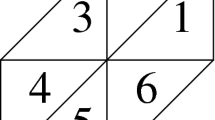Appendix 1.: Useful lemmas
The following lemmas play an important role in the construction of our approximation.
Lemma 2
Let \(\ell \in \mathbb {N}\) and ij ∈{1,⋯ ,d}, j = 1,⋯ ,ℓ, we define the polynomial of length \(\ell \in \mathbb {N}\) given by
$$ \begin{array}{@{}rcl@{}} \mathbb{W}_{(i_{1},\cdots,i_{\ell})}(t)=\mathbb{W}_{(i_{1},\cdots,i_{\ell-1})}(t) W^{i_{\ell}}_{t}-{{\int}_{0}^{t}} D_{i_{\ell},s} \mathbb{W}_{(i_{1},\cdots,i_{\ell-1})}(t) ds, t\geq 0, \end{array} $$
(A.1)
where Dℓ,⋅ is the Malliavin derivative for the Brownian motion Wℓ. Then, for all \(g\in {C}_{b}^{\infty }(\mathbb {R}^{N})\), we have
$$ \begin{array}{@{}rcl@{}} E[ g(\bar{X}_{t}^{x}) I_{(i_{1},\cdots,i_{\ell})}(t)]=E[ g(\bar{X}_{t}^{x}) \mathbb{W}_{(i_{1},\cdots,i_{\ell})}(t)]. \end{array} $$
(A.2)
Proof
Apply the computation of Proposition 3.1 of Naito and Yamada [8] (2019) iteratively. □
Lemma 3
Let ij ∈{0, 1,…,d}, j = 1, 2,…,k, k ≥ 3. Let \({\Delta }=\{ (s_{1},\cdots ,s_{r}) \in \mathbb {R}^{r} ; 0 \leq s_{1}<s_{2} <{\cdots } < s_{r} \leq T \}\) and h be a L2(Δ)-valued Wiener functional such that s1↦h(s1,…,sr) is adapted for fixed s1 < s2 < … < sr. Then, there are C > 0, \(L \in \mathbb {N} \cup \{0\}\) such that
$$ \begin{array}{@{}rcl@{}} \sup_{x \in \mathbb{R}^{N}}\left|E [g(\bar{X}_{t}^{x}){\int}_{0<t_{1}<\cdots<t_{k}<t}h(t_{1},\cdots,t_{k})dW_{t_{1}}^{i_{1}}{\cdots} dW^{i_{k}}_{t_{k}}]\right|\leq C\sum\limits_{\ell=0}^{L} \|\nabla^{\ell} g\| t^{3}, \end{array} $$
for t ≥ 0 and \(g\in {C}_{b}^{\infty }(\mathbb {R}^{N})\).
Proof
Apply the duality formula with Lemma 1 of Yamada and Yamamoto [14] (2018). □
Appendix 2.: Proof of Proposition 2
First, we expand \(\varphi ({X_{t}^{x}})\) around \(\varphi (\bar {X}_{t}^{x})\) using the following stochastic Taylor expansion of \({X_{t}^{x}}\):
$$ \begin{array}{@{}rcl@{}} X_{t}^{x,\ell}&=&\bar{X}_{t}^{x,\ell}+\sum\limits_{i_{1},i_{2}=0}^{d}L_{i_{1}}V_{i_{2}}^{\ell}(x)I_{(i_{1},i_{2})}(t)+\sum\limits_{i_{1},i_{2},i_{3}=0}^{d}L_{i_{1}}L_{i_{2}}V_{i_{3}}^{\ell}(x)I_{(i_{1},i_{2},i_{3})}(t)\\ &&+\mathcal{R}_{\ell}(t,x) \end{array} $$
with \(\textstyle {\mathcal {R}_{\ell }(t,x)={\sum }_{i_{1},i_{2},i_{3},i_{4}=0}^{d}{{\int \limits }_{0}^{t}}{\int \limits }_{0}^{t_{4}}{\int \limits }_{0}^{t_{3}}{\int \limits }_{0}^{t_{2}}L_{i_{1}}L_{i_{2}}L_{i_{3}}V_{i_{4}}^{\ell }(X_{t_{1}}^{x})dW_{t_{1}}^{i_{1}}dW_{t_{2}}^{i_{2}}dW_{t_{3}}^{i_{3}}dW_{t_{4}}^{i_{4}}}\), as follows:
$$ \begin{array}{@{}rcl@{}} \varphi({X_{t}^{x}})&=&\varphi(\bar{X}_{t}^{x})+\sum\limits_{\ell=1}^{N} \partial_{\ell}\varphi(\bar{X}_{t}^{x})\{X_{t}^{x,\ell}-\bar{X}_{t}^{x,\ell}\}\\ &&+\frac{1}{2}\sum\limits_{\ell_{1},\ell_{2}=1}^{N} \partial_{\ell_{1}}\partial_{\ell_{2}}\varphi(\bar{X}_{t}^{x}){\prod}_{k=1}^{2}\{X_{t}^{x,\ell_{k}}-\bar{X}_{t}^{x,\ell_{k}}\}+r_{\varphi}(t,x)\\ &=&\varphi(\bar{X}_{t}^{x})+\sum\limits_{\ell=1}^{N} \partial_{\ell}\varphi(\bar{X}_{t}^{x})\{\sum\limits_{i_{1},i_{2}=0}^{d}L_{i_{1}}V_{i_{2}}^{\ell}(x)I_{(i_{1},i_{2})}(t)\\ &&+\sum\limits_{i_{1},i_{2},i_{3}=0}^{d}L_{i_{1}}L_{i_{2}}V_{i_{3}}^{\ell}(x)I_{(i_{1},i_{2},i_{3})}(t)+\mathcal{R}_{\ell}(t,x)\}\\ &&+\frac{1}{2}\sum\limits_{\ell_{1},\ell_{2}=1}^{N} \partial_{\ell_{1}}\partial_{\ell_{2}}\varphi(\bar{X}_{t}^{x}){\prod}_{k=1}^{2}\{\sum\limits_{i_{1},i_{2}=0}^{d}L_{i_{1}}V_{i_{2}}^{\ell_{k}}(x)I_{(i_{1},i_{2})}(t)\\ &&+\sum\limits_{i_{1},i_{2},i_{3}=0}^{d}L_{i_{1}}L_{i_{2}}V_{i_{3}}^{\ell_{k}}(x)I_{(i_{1},i_{2},i_{3})}(t)+\mathcal{R}_{\ell_{k}}(t,x)\}\\ &&+r_{\varphi}(t,x), \end{array} $$
for a Wiener functional \(r_{\varphi }: [0,T] \times \mathbb {R} \times {\Omega } \rightarrow \mathbb {R}\) such that \(\| r_{\varphi }(t,x) \|_{p} \leq C \| \nabla ^{3} \varphi \|_{\infty } t^{3}\). We also expand \(J_{t}^{(i,j)}\), 1 ≤ i,j ≤ N as
$$ \begin{array}{@{}rcl@{}} J_{t}^{(i,j)}={\delta_{j}^{i}}+\sum\limits_{\ell=0}^{d}\partial_{i}V_{\ell}^{j}(x)I_{(\ell)}(t)+\sum\limits_{\ell_{1},\ell_{2}=0}^{d}\partial_{i}L_{\ell_{1}}V_{\ell_{2}}^{j}(x)I_{(\ell_{1},\ell_{2})}(t)+\mathcal{R}^{J}_{i,j}(t,x), \end{array} $$
where \(\textstyle {\mathcal {R}^{J}_{i,j}(t,x)={\sum }_{\ell _{1},\ell _{2},\ell _{3}=0}^{d}{{\int \limits }_{0}^{t}}{\int \limits }_{0}^{t_{3}}{\int \limits }_{0}^{t_{2}}\partial _{i}L_{\ell _{1}}L_{\ell _{2}}V_{\ell _{3}}^{j}(X_{t_{1}}^{x})dW_{t_{1}}^{\ell _{1}}dW_{t_{2}}^{\ell _{2}}dW_{t_{3}}^{\ell _{3}}}\).
Then, the expectation \(E[\varphi ({X_{t}^{x}})J_{t}^{(i,j)}]\) is expanded as follows:
$$ \begin{array}{@{}rcl@{}} &&E[\varphi({X_{t}^{x}})J_{t}^{(i,j)}]\\ &=&E[\varphi(\bar{X}_{t}^{x})\{{\delta_{j}^{i}}+\sum\limits_{k=0}^{d} \partial_{i} {V_{k}^{j}}(x)I_{(k)}(t)+ \sum\limits_{k_{1},k_{2}=0}^{d}\partial_{i} L_{k_{1}}V_{k_{2}}^{j}(x) I_{(k_{1},k_{2})}(t)+\mathcal{R}^{J}_{i,j}(t,x)\}]\\ &&+\sum\limits_{\ell=1}^{N}E[\partial_{\ell}\varphi(\bar{X}_{t}^{x})\sum\limits_{i_{1},i_{2}=0}^{d}L_{i_{1}}V_{i_{2}}^{\ell}(x)I_{(i_{1},i_{2})}(t)\times \{{\delta_{j}^{i}}+\sum\limits_{k=0}^{d}\partial_{i}{V_{k}^{j}}(x)I_{(k)}(t)\\ &&+\sum\limits_{k_{1},k_{2}=0}^{d}\partial_{i}L_{k_{1}}V_{k_{2}}^{j}(x) I_{(k_{1},k_{2})}(t)+\mathcal{R}^{J}_{i,j}(t,x)\}] \\ &&+\frac{1}{2}\sum\limits_{\ell_{1},\ell_{2}=1}^{N}E[\partial_{\ell_{1}}\partial_{\ell_{2}}\varphi(\bar{X}_{t}^{x}){\prod}_{k=1}^{2}\{\sum\limits_{i_{1},i_{2}=0}^{d}L_{i_{1}}V_{i_{2}}^{\ell_{k}}(x)I_{(i_{1},i_{2})}(t)\\ &&+\sum\limits_{i_{1},i_{2},i_{3}=0}^{d}L_{i_{1}}L_{i_{2}}V_{i_{3}}^{\ell_{k}}(x)I_{(i_{1},i_{2},i_{3})}(t)\\ &&+\mathcal{R}_{\ell_{k}}(t,x) \} \{{\delta_{j}^{i}}+\sum\limits_{\ell=0}^{d}\partial_{i}V_{\ell}^{j}(x)I_{(\ell)}(t)\\ &&+\sum\limits_{\ell_{1},\ell_{2}=0}^{d}\partial_{i}L_{\ell_{1}}V_{\ell_{2}}^{j}(x)I_{(\ell_{1},\ell_{2})}(t)+\mathcal{R}^{J}_{i,j}(t,x)\}]\\ &&+{\mathcal E}_{\varphi}(t,x), \end{array} $$
(B.1)
for a residual \({\mathcal E}_{\varphi }(t,x)\). Here, \({\mathcal E}_{\varphi }\) satisfies
$$ \begin{array}{@{}rcl@{}} \sup_{x \in \mathbb{R}^{N}} | {\mathcal E}_{\varphi}(t,x) | \leq C \| \nabla^{3} \varphi \|_{\infty} t^{3}, \end{array} $$
which is immediately obtained by standard moment estimates of iterated stochastic integrals.
We now estimate the expectations in (B.1) which will be the order O(t3) using Lemma 3. Note that the products of iterated stochastic integrals appearing in (B.1) can be written as follows:
$$ \begin{array}{@{}rcl@{}} I_{(k_{1})}(t)I_{(k_{2},k_{3})}(t)&=&I_{(k_{1},k_{2},k_{3})}(t)+I_{(k_{2},k_{1},k_{3})}(t)+I_{(k_{2},k_{3},k_{1})}(t)\\ &&+I_{(0,k_{3})}(t)\textbf{1}_{k_{1}=k_{2}\neq0}+I_{(k_{2},0)}(t)\textbf{1}_{k_{1}=k_{3}\neq0}, \end{array} $$
(B.2)
$$ \begin{array}{@{}rcl@{}} I_{(k_{1},k_{2})}(t)I_{(k_{3},k_{4})}(t) &=&I_{(k_{1},k_{2},k_{3},k_{4})}(t)+I_{(k_{1},k_{3},k_{2},k_{4})}(t)+I_{(k_{1},k_{3},k_{4},k_{2})}(t)\\ &&+I_{(k_{3},k_{4},k_{1},k_{2})}(t)+I_{(k_{3},k_{1},k_{4},k_{2})}(t)+I_{(k_{3},k_{1},k_{2},k_{4})}(t)\\ &&+I_{(k_{1},0,k_{4})}(t)\textbf{1}_{k_{2}=k_{3}\neq0}+I_{(k_{1},k_{3},0)}(t)\textbf{1}_{k_{2}=k_{4}\neq0}\\ &&+I_{(0,k_{4},k_{2})}(t)\textbf{1}_{k_{1}=k_{3}\neq0}+I_{(0,k_{2},k_{4})}(t)\textbf{1}_{k_{1}=k_{3}\neq0}\\ &&+I_{(k_{3},0,k_{2})}(t)\textbf{1}_{k_{1}=k_{4}\neq0}+I_{(k_{3},k_{1},0)}(t)\textbf{1}_{k_{2}=k_{4}\neq0}\\ &&+I_{(0,0)}\textbf{1}_{k_{1}=k_{3}\neq0,k_{2}=k_{4}\neq0}, \end{array} $$
(B.3)
$$ \begin{array}{@{}rcl@{}} &&I_{(k_{1},k_{2})}(t)I_{(k_{3},k_{4},k_{5})}(t)\\ &=&I_{(k_{1},k_{2},k_{3},k_{4},k_{5})}(t)+I_{(k_{1},k_{3},k_{2},k_{4},k_{5})}(t)+I_{(k_{1},k_{3},k_{4},k_{2},k_{5})}(t)+I_{(k_{1},k_{3},k_{4},k_{5},k_{2})}(t)\\ &&+I_{(k_{3},k_{4},k_{5},k_{1},k_{2})}(t)+I_{(k_{3},k_{4},k_{1},k_{5},k_{2})}(t)+I_{(k_{3},k_{4},k_{1},k_{2},k_{5})}(t)\\ &&+I_{(k_{3},k_{1},k_{4},k_{5},k_{2})}(t)+I_{(k_{3},k_{1},k_{4},k_{2},k_{5})}(t)+I_{(k_{3},k_{1},k_{2},k_{4},k_{5})}(t)\\ &&+I_{(k_{1},0,k_{4},k_{5})}(t)\textbf{1}_{k_{2}=k_{3}\neq0}+I_{(0,k_{2},k_{4},k_{5})}(t)\textbf{1}_{k_{1}=k_{3}\neq0}+I_{(k_{1},k_{3},0,k_{5})}(t)\textbf{1}_{k_{2}=k_{4}\neq0}\\ &&+I_{(k_{1},k_{3},k_{4},0)}(t)\textbf{1}_{k_{2}=k_{5}\neq0}+I_{(0,k_{4},k_{2},k_{5})}(t)\textbf{1}_{k_{1}=k_{3}\neq0}+I_{(0,k_{4},k_{5},k_{2})}(t)\textbf{1}_{k_{1}=k_{3}\neq0}\\ &&+I_{(k_{3},k_{4},0,k_{2})}(t)\textbf{1}_{k_{1}=k_{5}\neq0}+I_{(k_{3},0,k_{5},k_{2})}(t)\textbf{1}_{k_{1}=k_{4}\neq0}+I_{(k_{3},k_{4},k_{1},0)}(t)\textbf{1}_{k_{2}=k_{5}\neq0}\\ &&+I_{(k_{3},0,k_{2},k_{5})}(t)\textbf{1}_{k_{1}=k_{4}\neq0}+I_{(k_{3},k_{1},0,k_{5})}(t)\textbf{1}_{k_{2}=k_{4}\neq0}+I_{(k_{3},k_{1},k_{4},0)}(t)\textbf{1}_{k_{2}=k_{5}\neq0}\\ &&+I_{(0,0,k_{5})}\textbf{1}_{k_{1}=k_{3}\neq0,k_{2}=k_{4}\neq0} + I_{(0,k_{4},0)}\textbf{1}_{k_{1}=k_{3}\neq0,k_{2}=k_{5}\neq0} + I_{(k_{3},0,0)}\textbf{1}_{k_{1}=k_{4}\neq0,k_{2}=k_{5}\neq0}.\\ && \end{array} $$
(B.4)
By Lemma 3, the expectations involving single iterated stochastic integral of the length greater than k ≥ 3 will be O(t3). Then, we obtain
$$ \begin{array}{@{}rcl@{}} E[\varphi(\bar{X}_{t}^{x}) J_{t}^{(i,j)} ]&=&E[\varphi(\bar{X}_{t}^{x})\{{\delta_{j}^{i}}+\sum\limits_{k=0}^{d} \partial_{i} {V_{k}^{j}}(x){W_{t}^{k}}\\ &&+ \sum\limits_{k_{1},k_{2}=0}^{d}\partial_{i} L_{k_{1}}V_{k_{2}}^{j}(x) I_{(k_{1},k_{2})}(t)\}]\\ &&+\sum\limits_{\ell=1}^{N}E [\partial_{\ell}\varphi(\bar{X}_{t}^{x})\sum\limits_{k_{1},k_{2}=0}^{d}L_{k_{1}}V_{k_{2}}^{\ell}(x)I_{(k_{1},k_{2})}(t){\delta_{j}^{i}}]\\ &&+\sum\limits_{\ell=1}^{N}E[\partial_{\ell}\varphi(\bar{X}_{t}^{x})\sum\limits_{k,k_{1},k_{2}=0}^{d}L_{k_{1}}V_{k_{2}}^{\ell}(x)\partial_{i}{V_{k}^{j}}(x)\{ I_{(k_{1},0)}(t)\textbf{1}_{k=k_{2}\neq0} \\ &&+I_{(0,k_{2})}(t) \textbf{1}_{k=k_{1}\neq0} \}]\\ &&+\sum\limits_{\ell=1}^{N}E[\partial_{\ell}\varphi(\bar{X}_{t}^{x})\sum\limits_{k_{1},k_{2}=1}^{d}L_{k_{1}}V_{k_{2}}^{\ell}(x)\partial_{i}L_{k_{1}}V_{k_{2}}^{j}(x)I_{(0,0)}(t)]\\ &&+\frac{1}{2}\sum\limits_{\ell_{1},\ell_{2}=1}^{N}E[\partial_{\ell_{1}}\partial_{\ell_{2}}\varphi(\bar{X}_{t}^{x})\!\sum\limits_{i_{1},i_{2}=1}^{d}L_{i_{1}}V_{i_{2}}^{\ell_{1}}(x)L_{i_{1}}V_{i_{2}}^{\ell_{2}}(x) I_{(0,0)}(t){\delta_{j}^{i}}]\\ &&+R_{\varphi}(t,x), \end{array} $$
(B.5)
where Rφ(t,x) satisfies
$$ \begin{array}{@{}rcl@{}} \sup_{x \in \mathbb{R}^{N}} | R_{\varphi}(t,x) | \leq C \| \nabla^{4} \varphi \|_{\infty} t^{3}. \end{array} $$
Appendix 3.: Proof of Proposition 3
We immediately have
$$ \begin{array}{@{}rcl@{}} E[\varphi(\mathbb{X}_{t}^{x})\mathbb{J}_{t}^{(i,j)}]&=&E[\varphi(\bar{X}_{t}^{x})\mathbb{J}_{t}^{(i,j)}]+\sum\limits_{\ell=1}^{N}E[\partial_{\ell}\varphi\left( \bar{X}_{t}^{x}\right)\{\mathbb{X}_{t}^{x,\ell}-\bar{X}_{t}^{x,\ell}\}\mathbb{J}_{t}^{(i,j)}]\\ && +\frac{1}{2}\sum\limits_{\ell_{1},\ell_{2}=1}^{N}E[\partial_{\ell_{1}}\partial_{\ell_{2}}\varphi\left( \bar{X}_{t}^{x}\right){\prod}_{m=1}^{2}\{\mathbb{X}_{t}^{x,\ell_{m}}-\bar{X}_{t}^{x,\ell_{m}}\}\mathbb{J}_{t}^{(i,j)}]\\ &&+O(t^{3}). \end{array} $$
(C.1)
Here, the residual order O(t3) is immediately obtained by the moment estimate of iterated stochastic integrals. We next apply Lemma 3 in order to get the following:
$$ \begin{array}{@{}rcl@{}} &&E[\varphi(\mathbb{X}_{t}^{x})\mathbb{J}_{t}^{(i,j)}]\\ &=&E[\varphi(\bar{X}_{t}^{x})\{{\delta_{j}^{i}}+\sum\limits_{k=0}^{d}\partial_{i}{V_{k}^{j}}(x){W_{t}^{k}}+\sum\limits_{k_{1},k_{2}=0}^{d}\partial_{i}L_{k_{1}}V_{k_{2}}^{j}(x)\\ &&\times\frac{1}{2}\{W_{t}^{k_{1}}W_{t}^{k_{2}}-t\textbf{1}_{k_{1}=k_{2}\neq0}\}\}]\\ &&+\sum\limits_{\ell=1}^{N}E[\partial_{\ell}\varphi (\bar{X}_{t}^{x}) [\sum\limits_{k_{1},k_{2}=0}^{d}L_{k_{1}}V_{k_{2}}^{\ell}(x)\frac{1}{2}\{W_{t}^{k_{1}}W_{t}^{k_{2}}-t\textbf{1}_{k_{1}=k_{2}\neq0}\}{\delta_{j}^{i}} \end{array} $$
(C.2)
$$ \begin{array}{@{}rcl@{}} &&+\sum\limits_{k,k_{1},k_{2}=0}^{d}L_{k_{1}}V_{k_{2}}^{\ell}(x)\partial_{i}{V_{k}^{j}}(x){W_{t}^{k}}\frac{1}{2}\{W_{t}^{k_{1}}W_{t}^{k_{2}}-t\textbf{1}_{k_{1}=k_{2}\neq0}\} \end{array} $$
(C.3)
$$ \begin{array}{@{}rcl@{}} &&+\sum\limits_{k_{1},k_{2}=1}^{d}\{ L_{k_{1}}V_{k_{2}}^{\ell}(x)\partial_{i}L_{k_{1}}V_{k_{2}}^{j}(x)+L_{k_{1}}V_{k_{2}}^{\ell}(x)\partial_{i}L_{k_{2}}V_{k_{1}}^{j}(x)\}\frac{1}{4}t^{2} ]\\ &&+\frac{1}{2}\sum\limits_{\ell_{1},\ell_{2}=1}^{N}E[\partial_{\ell_{1}}\partial_{\ell_{2}}\varphi(\bar{X}_{t}^{x})[\sum\limits_{k_{1},k_{2}=1}^{d}\{L_{k_{1}}V_{k_{2}}^{\ell_{1}}(x)L_{k_{1}}V_{k_{2}}^{\ell_{2}}(x)\\ &&+L_{k_{1}}V_{k_{2}}^{\ell_{1}}(x)L_{k_{2}}V_{k_{1}}^{\ell_{2}}(x) \}\frac{1}{4}t^{2}{\delta_{j}^{i}}]]\\ &&+{O}(t^{3}). \end{array} $$
(C.4)
Appendix 4.: Proof of Proposition 4
By applying Lemma 2 and Lemma 3, we have
$$ \begin{array}{@{}rcl@{}} &&\sum\limits_{\ell=1}^{N}E[\partial_{\ell}\varphi(\bar{X}_{t}^{x})\sum\limits_{k,k_{1},k_{2}=0}^{d}L_{k_{1}}V_{k_{2}}^{\ell}(x)\partial_{i}{V_{k}^{j}}(x)\frac{1}{2}\{{W_{t}^{k}}W_{t}^{k_{1}}W_{t}^{k_{2}}-t{W_{t}^{k}}{\textbf{1}}_{k_{1}=k_{2}\neq0}\}]\\ &=&\sum\limits_{\ell=1}^{N}E[\partial_{\ell}\varphi(\bar{X}_{t}^{x})\sum\limits_{k,k_{1},k_{2}=0}^{d}L_{k_{1}}V_{k_{2}}^{\ell}(x)\partial_{i}{V_{k}^{j}}(x) \frac{1}{2}\{{W_{t}^{k}}W_{t}^{k_{1}}W_{t}^{k_{2}}\\ &&-(t{W_{t}^{k}}{\textbf{1}}_{k_{1}=k_{2}\neq0}+tW_{t}^{k_{1}}{\textbf{1}}_{k=k_{2}\neq0}+tW_{t}^{k_{2}}{\textbf{1}}_{k=k_{1}\neq0} )+(tW_{t}^{k_{1}}{\textbf{1}}_{k=k_{2}\neq0}+tW_{t}^{k_{2}}{\textbf{1}}_{k=k_{1}\neq0} )\}]\\ &=&\sum\limits_{\ell=1}^{N}E[\partial_{\ell}\varphi(\bar{X}_{t}^{x})\sum\limits_{k,k_{1},k_{2}=0}^{d}L_{k_{1}}V_{k_{2}}^{\ell}(x)\partial_{i}{V_{k}^{j}}(x)\\ &&\times\frac{1}{2}\{6{\int}_{0<t_{1}<\cdots<t_{3}<t}dW_{t_{1}}^{k}dW_{t_{2}}^{k_{1}}dW_{t_{3}}^{k_{2}}+(tW_{t}^{k_{1}}{\textbf{1}}_{k=k_{2}\neq0}+tW_{t}^{k_{2}}{\textbf{1}}_{k=k_{1}\neq0} )\}]\\ &=&\sum\limits_{\ell=1}^{N}E[\partial_{\ell}\varphi(\bar{X}_{t}^{x})\sum\limits_{k,k_{1},k_{2}=0}^{d}L_{k_{1}}V_{k_{2}}^{\ell}(x)\partial_{i}{V_{k}^{j}}(x)\frac{1}{2}\{tW_{t}^{k_{1}}\textbf{1}_{k=k_{2}\neq0}+tW_{t}^{k_{2}}\textbf{1}_{k=k_{1}\neq0}\}]+{O}(t^{3}). \end{array} $$
Appendix 5.: Proof of Proposition 5
We immediately have
$$ \begin{array}{@{}rcl@{}} &&E[\varphi (\widetilde{X}_{t}^{x} )\widetilde{J}_{t}^{(i,j)}]\\ &=&E[\varphi (\bar{X}_{t}^{x} )\{{\delta_{j}^{i}}+\sum\limits_{k=0}^{d}\partial_{i}{V_{k}^{j}}(x){W_{t}^{k}}+\sum\limits_{k_{1},k_{2}=0}^{d}\partial_{i}L_{k_{1}}V_{k_{2}}^{j}(x)\frac{1}{2} \{W_{t}^{k_{1}}W_{t}^{k_{2}}-t\textbf{1}_{k_{1}=k_{2}\neq0}\} \} ]\\ &&+\sum\limits_{\ell=1}^{N} E[\varphi (\bar{X}_{t}^{x} )\sum\limits_{\ell=1}^{N}\sum\limits_{k_{1},k_{2}=1}^{d}\frac{1}{4}L_{k_{1}}V^{\ell}_{k_{2}}(x)\{\partial_{i}L_{k_{1}}V_{k_{2}}^{j}(x)-\partial_{i}L_{k_{2}}V_{k_{1}}^{j}(x)\} H_{(\ell)}(\bar{X}_{t}^{x},1) ]t^{2} \end{array} $$
(E.1)
$$ \begin{array}{@{}rcl@{}} &&+\sum\limits_{\ell=1}^{N} E[\partial_{\ell}\varphi(\bar{X}_{t}^{x})\sum\limits_{k_{1},k_{2}=0}^{d}L_{k_{1}}V_{k_{2}}^{\ell}(x)\frac{1}{2}\{W_{t}^{k_{1}}W_{t}^{k_{2}}-t \textbf{1}_{k_{1}=k_{2}\neq0}\}]]{\delta_{j}^{i}}\\ &&+\sum\limits_{\ell=1}^{N} E[\partial_{\ell}\varphi (\bar{X}_{t}^{x} )\sum\limits_{k,k_{1},k_{2}=0}^{d} L_{k_{1}}V_{k_{2}}^{\ell}(x)\partial_{i}{V_{k}^{j}}(x) \frac{1}{2}t \{ W_{t}^{k_{1}} \textbf{1}_{k=k_{2}\neq 0}+W_{t}^{k_{2}} \textbf{1}_{k=k_{1}\neq 0}\}]\\ &&+\sum\limits_{\ell=1}^{N} E[\partial_{\ell}\varphi(\bar{X}_{t}^{x})\sum\limits_{k_{1},k_{2}=1}^{d}\{ L_{k_{1}}V_{k_{2}}^{\ell}(x)\partial_{i}L_{k_{1}}V_{k_{2}}^{j}(x)+L_{k_{1}}V_{k_{2}}^{\ell}(x)\partial_{i}L_{k_{2}}V_{k_{1}}^{j}(x) \} \frac{1}{4}t^{2} ] \\ &&+\frac{1}{2}\sum\limits_{\ell_{1},\ell_{2}=1}^{N}E[\partial_{\ell_{1}}\partial_{\ell_{2}}\varphi(\bar{X}_{t}^{x})[\sum\limits_{k_{1},k_{2}=1}^{d}\{ L_{k_{1}}V_{k_{2}}^{\ell_{1}}(x)L_{k_{1}}V_{k_{2}}^{\ell_{2}}(x)+L_{k_{1}}V_{k_{2}}^{\ell_{1}}(x)L_{k_{2}}V_{k_{1}}^{\ell_{2}}(x)\} \frac{1}{4}t^{2}{\delta_{j}^{i}}]]\\ &&+\sum\limits_{j=1}^{N} E[\partial_{\ell_{1}}\varphi(\bar{X}_{t}^{x}) \sum\limits_{\ell_{2}=1}^{N}\sum\limits_{k_{1},k_{2}=1}^{d}\frac{1}{8}L_{k_{1}}V^{\ell_{1}}_{k_{2}}(x)\{L_{k_{1}}V_{k_{2}}^{\ell_{2}}(x)-L_{k_{2}}V_{k_{1}}^{\ell_{2}}(x)\} H_{(\ell_{2})}(\bar{X}_{t}^{x},1){\delta_{j}^{i}}] t^{2}\\ &&+O(t^{3}). \end{array} $$
(E.2)
Using the following identities
$$ \begin{array}{@{}rcl@{}} E[\varphi (\bar{X}_{t}^{x} ) H_{(\ell)}(\bar{X}_{t}^{x},1) ]&=&E[\partial_{\ell} \varphi (\bar{X}_{t}^{x} ) ], E[\partial_{\ell_{1}}\varphi (\bar{X}_{t}^{x} ) H_{(\ell_{2})}(\bar{X}_{t}^{x},1) ]\\ &=&E[\partial_{\ell_{1}}\partial_{\ell_{2}} \varphi (\bar{X}_{t}^{x} ) ] \end{array} $$
and linearity of expectation, we have
$$ \begin{array}{@{}rcl@{}} E[\varphi (\widetilde{X}_{t}^{x} )\widetilde{J}_{t}^{(i,j)}] &=&E[\varphi (\bar{X}_{t}^{x})\{{\delta_{j}^{i}}+\sum\limits_{k=0}^{d}\partial_{i}{V_{k}^{j}}(x){W_{t}^{k}}+\sum\limits_{k_{1},k_{2}=0}^{d}\partial_{i}L_{k_{1}}V_{k_{2}}^{j}(x)\\ &&\times \frac{1}{2} \{W_{t}^{k_{1}}W_{t}^{k_{2}}-t\textbf{1}_{k_{1}=k_{2}\neq 0}\}\}]\\ &&+\sum\limits_{\ell=1}^{N}E[\partial_{\ell}\varphi(\bar{X}_{t}^{x})\sum\limits_{k_{1},k_{2}=0}^{d}L_{k_{1}}V_{k_{2}}^{\ell}(x)\frac{1}{2}\{W_{t}^{k_{1}}W_{t}^{k_{2}}-t \textbf{1}_{k_{1}=k_{2}\neq 0}\}]{\delta_{j}^{i}}\\ &&+\sum\limits_{\ell=1}^{N} E[\partial_{\ell}\varphi (\bar{X}_{t}^{x} )\sum\limits_{k,k_{1},k_{2}=0}^{d} L_{k_{1}}V_{k_{2}}^{\ell}(x)\partial_{i}{V_{k}^{j}}(x)\\ &&\times\frac{1}{2}t \{ W_{t}^{k_{1}} \textbf{1}_{k=k_{2}\neq 0}+W_{t}^{k_{2}} \textbf{1}_{k=k_{1}\neq 0}\}]\\ &&+\sum\limits_{\ell=1}^{N}E[\partial_{\ell}\varphi (\bar{X}_{t}^{x} )\sum\limits_{k_{1},k_{2}=1}^{d}L_{k_{1}}V_{k_{2}}^{\ell}(x)\partial_{i}L_{k_{1}}V_{k_{2}}^{j}(x) \frac{1}{2}t^{2} ] \\ &&+\frac{1}{4}\sum\limits_{\ell_{1},\ell_{2}=1}^{N} E[\partial_{\ell_{1}}\partial_{\ell_{2}}\varphi (\bar{X}_{t}^{x} )\sum\limits_{k_{1},k_{2}=1}^{d}L_{k_{1}}V_{k_{2}}^{\ell_{1}}(x)L_{k_{1}}V_{k_{2}}^{\ell_{2}}(x) t^{2} ]{\delta_{j}^{i}} \\ &&+O(t^{3}). \end{array} $$
Appendix 6.: Proof of Theorem 3
Since we have
$$ \begin{array}{@{}rcl@{}} \frac{\partial}{\partial x_{i}}E[ f({X_{t}^{x}}) ]= \sum\limits_{k=1}^{N} E[ g_{k}({X_{t}^{x}}) J_{t}^{(i,k)} ], \end{array} $$
(F.1)
we aim to expand \(E[ g_{k}({X_{t}^{x}}) J_{t}^{i,k} ]\) using distribution theory on the Wiener space in order to get the error bound with \(\| g \|_{\infty }\). Let us consider
$$ \begin{array}{@{}rcl@{}} dX_{t}^{x,\varepsilon}=\varepsilon^{2} V_{0}(X_{t}^{x,\varepsilon})dt+\varepsilon \sum\limits_{i=1}^{d} V_{i}(X_{t}^{x,\varepsilon})d{W_{t}^{i}}, X_{0}^{x,\varepsilon}=x, \end{array} $$
(F.2)
for ε ∈ (0, 1]. We have the stochastic Taylor expansions:
$$ \begin{array}{@{}rcl@{}} X_{t}^{x,k,\varepsilon}&=&x_{k} +\varepsilon^{2} {V^{k}_{0}}(x)t+ \varepsilon \sum\limits_{i=1}^{d} {V^{k}_{i}}(x) {W_{t}^{i}}\\ &&+\varepsilon^{2} \sum\limits_{i_{1},i_{2}=1}^{d} L_{i_{1}}V^{k}_{i_{2}}(x) {{\int}_{0}^{t}}{\int}_{0}^{t_{2}} dW_{t_{1}}^{i_{1}} dW_{t_{2}}^{i_{2}}+R^{k,\varepsilon}(t,x),\\ J_{t}^{(i,k),\varepsilon}&=&{\delta_{k}^{i}} + \varepsilon \sum\limits_{j=1}^{d} \partial_{i}{V^{k}_{j}}(x) {W_{t}^{j}}+\varepsilon^{2} \partial_{i}{V^{k}_{0}}(x)t\\ &&+\varepsilon^{2} \sum\limits_{j_{1},j_{2}=1}^{d} \partial_{i} L_{j_{1}}V^{k}_{j_{2}}(x) {{\int}_{0}^{t}}{\int}_{0}^{t_{2}} dW_{t_{1}}^{j_{1}} dW_{t_{2}}^{j_{2}}+E^{(i,k),\varepsilon}(t,x) \end{array} $$
with the remainders Rk,ε(t,x) and E(i,k),ε(t,x), respectively. We define \(\textstyle {Y_{t}^{x,\varepsilon }=(X_{t}^{x,\varepsilon }-x-\varepsilon ^{2} V_{0}(x)t)/\varepsilon }\) and then
$$ \begin{array}{@{}rcl@{}} Y_{t}^{x,\varepsilon}=\sum\limits_{i=1}^{d} V_{i}(x) {W_{t}^{i}}+\varepsilon \sum\limits_{i_{1},i_{2}=1}^{d} L_{i_{1}}V_{i_{2}}(x) {{\int}_{0}^{t}}{\int}_{0}^{t_{2}} dW_{t_{1}}^{i_{1}} dW_{t_{2}}^{i_{2}}+r^{\varepsilon}(t,x), \end{array} $$
(F.3)
for a Wiener functional rε(t,x). Let \(Y_{t}^{x,0}:=\sum \limits _{i=1}^{d} V_{i}(x) {W_{t}^{i}}\). Since it holds
$$ \begin{array}{@{}rcl@{}} E[ g_{k}(X_{t}^{x,\varepsilon}) J_{t}^{(i,k),\varepsilon} ]={\int}_{\mathbb{R}^{N}} g_{k}(x+\varepsilon^{2} V_{0}(x)t+\varepsilon y) \langle \delta_{y} (Y_{t}^{x,\varepsilon} ), J_{t}^{(i,k),\varepsilon} \rangle dy, \end{array} $$
(F.4)
we next expand \(\langle \delta _{y} (Y_{t}^{x,\varepsilon } ), J_{t}^{(i,k),\varepsilon } \rangle \). We have the following:
$$ \begin{array}{@{}rcl@{}} \langle \delta_{y} (Y_{t}^{x,\varepsilon} ), J_{t}^{(i,k),\varepsilon} \rangle &=& \langle \delta_{y} (Y_{t}^{x,0} ), 1 \rangle {\delta_{k}^{i}} + \varepsilon \langle \delta_{y} (Y_{t}^{x,0} ), \sum\limits_{j=1}^{d} \partial_{i}{V^{k}_{j}}(x) {W_{t}^{j}} \rangle \\ && + \varepsilon \sum \langle \partial_{\ell} \delta_{y} (Y_{t}^{x,0} ), \sum\limits_{i_{1},i_{2}=1}^{d} L_{i_{1}}V^{\ell}_{i_{2}}(x) {{\int}_{0}^{t}}{\int}_{0}^{t_{2}} dW_{t_{1}}^{i_{1}} dW_{t_{2}}^{i_{2}}\rangle {\delta_{k}^{i}} \\ && + \varepsilon^{2} {{\int}_{0}^{1}} (1-u) \langle \delta_{y} (Y_{t}^{x,\varepsilon u} ), F^{\varepsilon u}(t,x) \rangle du \end{array} $$
(F.5)
where \(F^{\lambda }(t,x) \in \mathbb {D}^{\infty }\) is given by
$$ \begin{array}{@{}rcl@{}} F^{\lambda}(t,x)&=&\sum\limits_{k_{1},k_{2}=1}^{N} H_{(k_{1},k_{2})} \left( Y_{t}^{x,\lambda}, \frac{\partial}{\partial \lambda} Y_{t}^{x,k_{1},\lambda} \frac{\partial}{\partial \lambda} Y_{t}^{x,k_{2},\lambda} J_{t}^{(i,k),\lambda} \right)\\ &&+\sum\limits_{k_{1}=1}^{N} H_{(k_{1})} \left( Y_{t}^{x,\lambda}, \frac{\partial^{2}}{\partial \lambda^{2}} Y_{t}^{x,k_{1},\lambda} J_{t}^{(i,k),\lambda} \right)\\ &&+2\sum\limits_{k_{1}=1}^{N} H_{(k_{1})} \left( Y_{t}^{x,\lambda}, \frac{\partial}{\partial \lambda} Y_{t}^{x,k_{1},\lambda} \frac{\partial}{\partial \lambda} J_{t}^{(i,k),\lambda} \right) + \frac{\partial^{2}}{\partial \lambda^{2}} J_{t}^{(i,k),\lambda} \end{array} $$
for λ ∈ [0, 1], which satisfies that for all k ≥ 1, \(p \in [1,\infty )\) and multi-index α, there is C > 0 such that
$$ \begin{array}{@{}rcl@{}} \sup_{\lambda \in [0,1], x \in \mathbb{R}^{N}}\| F^{\lambda}(t,x) \|_{k,p} \leq C t \end{array} $$
(F.6)
for all t ∈ (0,T]. Here, we used the estimate of Kusuoka and Stroock [7] (1984): for \(\alpha =(\alpha _{1},\cdots ,\alpha _{k}) \in \{1,\cdots ,N \}^{k}\), \(p \in [1,\infty )\), there exist C > 0, \(\ell \in \mathbb {N}\), \(q \in [1,\infty )\) such that
$$ \begin{array}{@{}rcl@{}} \| H_{\alpha}(Y_{t}^{x,\lambda}, G )\|_{p} \leq C t^{-|\alpha|/2} \| G \|_{\ell,q}, \end{array} $$
(F.7)
for t > 0, and the estimates for stochastic integrals: for \(i \in \mathbb {N}\), \(k \in \mathbb {N}\), \(p \in [1,\infty )\), there exists C > 0 such that
$$ \begin{array}{@{}rcl@{}} \left\| \frac{\partial^{i}}{\partial \varepsilon^{i}} Y_{t}^{x,j,\varepsilon} \right\|_{k,p} \leq C t^{(i+1)/2}, \left\| \frac{\partial^{i}}{\partial \varepsilon^{i}} J_{t}^{(j,k),\varepsilon} \right\|_{k,p} \leq C t^{i/2}, \end{array} $$
(F.8)
for t > 0. The third term of the expansion coefficient in (F.5) is obtained as
$$ \begin{array}{@{}rcl@{}} &&\langle \partial_{\ell} \delta_{y} (Y_{t}^{x,0} ), L_{i_{1}}V^{\ell}_{i_{2}}(x) {{\int}_{0}^{t}}{\int}_{0}^{t_{2}} dW_{t_{1}}^{i_{1}} dW_{t_{2}}^{i_{2}}\rangle\\ &=& \langle \partial_{\ell} \delta_{y} (V(x) \cdot ), E[ L_{i_{1}}V^{\ell}_{i_{2}}(x) {{\int}_{0}^{t}}{\int}_{0}^{t_{2}} dW_{t_{1}}^{i_{1}} dW_{t_{2}}^{i_{2}}|W_{t}=\cdot ] \rangle \end{array} $$
with
$$ \begin{array}{@{}rcl@{}} &&E[ L_{i_{1}}V^{\ell}_{i_{2}}(x) {{\int}_{0}^{t}}{\int}_{0}^{t_{2}} dW_{t_{1}}^{i_{1}} dW_{t_{2}}^{i_{2}}|W_{t}=\cdot ]\\ &=& \langle \delta_{\cdot} (W_{t}),L_{i_{1}}V^{\ell}_{i_{2}}(x) {{\int}_{0}^{t}}{\int}_{0}^{t_{2}} dW_{t_{1}}^{i_{1}} dW_{t_{2}}^{i_{2}} \rangle\\ &=& \langle \delta_{\cdot} (W_{t}),L_{i_{1}}V^{\ell}_{i_{2}}(x) \frac{1}{2} \{ W_{t}^{i_{1}}W_{t}^{i_{2}} - t \textbf{1}_{i_{1}=i_{2}} \} \rangle\\ &=&E[ L_{i_{1}}V^{\ell}_{i_{2}}(x) \frac{1}{2} \{ W_{t}^{i_{1}}W_{t}^{i_{2}} - t \textbf{1}_{i_{1}=i_{2}} \}|W_{t} = \cdot ]. \end{array} $$
Then, we have
$$ \begin{array}{@{}rcl@{}} \langle \partial_{\ell} \delta_{y} (Y_{t}^{x,0} ), L_{i_{1}}V^{\ell}_{i_{2}}(x) {{\int}_{0}^{t}}{\int}_{0}^{t_{2}} dW_{t_{1}}^{i_{1}} dW_{t_{2}}^{i_{2}}\rangle =_{{\mathcal S}^{\prime}} \langle \partial_{\ell} \delta_{y} (V(x) \cdot ), E[ L_{i_{1}}V^{\ell}_{i_{2}}(x) \frac{1}{2} \{ W_{t}^{i_{1}}W_{t}^{i_{2}} -t \textbf{1}_{i_{1}=i_{2}} \}|W_{t}=\cdot]p^{W_{t}}(\cdot) \rangle_{{\mathcal S}} = \langle \partial_{\ell} \delta_{y} (Y_{t}^{x,0} ), L_{i_{1}}V^{\ell}_{i_{2}}(x) \frac{1}{2} \{ W_{t}^{i_{1}}W_{t}^{i_{2}} -t \textbf{1}_{i_{1}=i_{2}} \} \rangle\\ = \langle \delta_{y} (Y_{t}^{x,0} ), \sum\limits_{e=1}^{N} \sum\limits_{j_{1},j_{2},j_{3}=1}^{d} L_{j_{1}}V_{j_{2}}^{\ell}(x)V_{j_{3}}^{e}(x)A_{\ell e}(x)\\ \frac{1}{2t}\{ W^{j_{1}}_{t}W^{j_{2}}_{t}W^{j_{3}}_{t} -W^{j_{1}}_{t} t \textbf{1}_{j_{2}=j_{3}} -W^{j_{2}}_{t} t \textbf{1}_{j_{1}=j_{3}} -W^{j_{3}}_{t} t \textbf{1}_{j_{1}=j_{2}} \} \rangle. \end{array} $$
Here, \(p^{W_{t}}\) is the density of Wt. Letting ε = 1, we have
$$ \begin{array}{@{}rcl@{}} E[ g_{k}({X_{t}^{x}}) J_{t}^{i,k} ]&=&E[ g_{k}(\bar{X}_{t}^{x}) ] {\delta_{k}^{i}} + E[ g_{k}(\bar{X}_{t}^{x}) \sum\limits_{j=1}^{d} \partial_{i}{V^{k}_{j}}(x) {W_{t}^{j}} ] \\ && + E[ g_{k}({X_{t}^{x}}) \sum\limits_{e=1}^{N} \sum\limits_{j_{1},j_{2},j_{3}=1}^{d} L_{j_{1}}V_{j_{2}}^{\ell}(x)V_{j_{3}}^{e}(x)A_{\ell e}(x)\\ && \frac{1}{2t}\{ W^{j_{1}}_{t}W^{j_{2}}_{t}W^{j_{3}}_{t} -W^{j_{1}}_{t} t \textbf{1}_{j_{2}=j_{3}} -W^{j_{2}}_{t} t \textbf{1}_{j_{1}=j_{3}} -W^{j_{3}}_{t} t \textbf{1}_{j_{1}=j_{2}} \} ]{\delta_{k}^{i}}\\ && + \mathscr{R}(t,x), \end{array} $$
where
$$ \begin{array}{@{}rcl@{}} \mathscr{R}(t,x)={{\int}_{0}^{1}} (1-u) E[ g_{k}(\hat{X}_{t}^{x,u}) F^{u}(t,x) ) ] du \end{array} $$
with \(\hat {X}_{t}^{x,\lambda }=x+V_{0}(x)t+Y_{t}^{x,\lambda }\), λ ∈ [0, 1], which satisfies \(\textstyle {\sup _{x \in \mathbb {R}^{N}}| {\mathscr{R}}(t,x) |\leq C \| g \|_{\infty } t}\) for some C > 0 independent of the function g and t > 0 obtained by the estimate (F.6).
Therefore, we get
$$ \begin{array}{@{}rcl@{}} \sup_{x \in \mathbb{R}^{N}} \Big|\frac{\partial}{\partial x_{i}}E[ f({X_{t}^{x}}) ]-\sum\limits_{k=1}^{N} \widehat{Q_{t}^{J,(i,k)}} g_{k}(x) \Big| \leq C \| g \|_{\infty} t. \end{array} $$
(F.9)
Appendix 7.: Proof of Lemma 1
We have already seen that (5.28) holds, i.e., for smooth \(\varphi :\mathbb {R}^{N} \rightarrow \mathbb {R}\),
$$ \begin{array}{@{}rcl@{}} \| P_{s}^{J,(i,j)}\varphi - Q_{s}^{J,(i,j)}\varphi \|_{\infty} \leq C \sum\limits_{e=1}^{4}\|\nabla^{e} \varphi\|_{\infty} s^{3}. \end{array} $$
(G.1)
We note even if gk is not smooth (only bounded and measurable), x↦PJ,(j,k)gk(x) is smooth. To finish the proof, we will give the upper bound of
$$ \begin{array}{@{}rcl@{}} \|\nabla^{e} P_{T-t}^{J,(j,k)}g_{k} \|_{\infty}, \text{for} e=1,\cdots,4. \end{array} $$
The expectation \(P_{t}^{J,(j,k)}g_{k}(x)\) has the following form:
$$ \begin{array}{@{}rcl@{}} E[ g_{k}({X_{t}^{x}}) G(t,x) ] = {\int}_{\mathbb{R}^{N}} g_{k} (y) \langle \delta_{y} ({X_{t}^{x}}), G(t,x) \rangle dy, \end{array} $$
for a Wiener fucntional \(G(t,x) \in \mathbb {D}^{\infty }\) such that for all m ≥ 1, \(p \in [1,\infty )\) and and multi-index α, there is C > 0 such that \(\textstyle {\sup _{x \in \mathbb {R}^{N}}\|\frac {\partial ^{\alpha }}{\partial x^{\alpha }}G(t,x) \|_{m,p} \leq C}\) for all t ∈ (0,T]. Also remark that we have that for all m ≥ 1, \(p \in [1,\infty )\) and and multi-index α, there is C > 0 such that \(\textstyle {\sup _{x \in \mathbb {R}^{N}}\|\frac {\partial ^{\alpha }}{\partial x^{\alpha }}{X_{t}^{x}} \|_{m,p} \leq C}\) for all t ∈ (0,T]. By the integration by parts, we have
$$ \begin{array}{@{}rcl@{}} \frac{\partial^{\alpha}}{\partial x^{\alpha}} \langle \delta_{y} ({X_{t}^{x}}), G(t,x) \rangle&=&\sum\limits_{m=1}^{|\alpha|} \sum\limits_{\ell=1}^{p(m)} \sum\limits_{{\upbeta}^{\ell} \in \{1,\cdots,N \}^{m}} \langle \partial^{{\upbeta}^{\ell}} \delta_{y} ({X_{t}^{x}}), \widetilde{G}_{{\upbeta}^{\ell}} (t,x) \rangle\\ &=&\sum\limits_{m=1}^{|\alpha|} \sum\limits_{\ell=1}^{p(m)} \sum\limits_{{\upbeta}^{\ell} \in \{1,\cdots,N \}^{m}} \langle \delta_{y} ({X_{t}^{x}}), H_{{\upbeta}^{\ell}} ({X_{t}^{x}}, \widetilde{G}_{{\upbeta}^{\ell}} (t,x) ) \rangle, \end{array} $$
for some \(p(m) \in \mathbb {N}\), βℓ ∈{1,⋯ ,N}m and \(\widetilde {G}_{{\upbeta }^{\ell }} (t,x) \in \mathbb {D}^{\infty }\) for m = 1,⋯ ,|α| and ℓ = 1,⋯ ,p(m). Here, \(\widetilde {G}_{\upbeta } (t,x)\), β ∈{1,⋯ ,N}m, m ≤|α| are given by some products of the functionals \(\textstyle {\frac {\partial ^{\gamma }}{\partial x^{\gamma }}G(t,x)}\), γ ∈{1,⋯ ,N}k, k ≤|α|. The weight \(H_{\upbeta } ({X_{t}^{x}}, \widetilde {G}_{\upbeta } (t,x) )\) for such \(\widetilde {G}_{\upbeta } (t,x)\) is estimated through the result in Kusuoka and Stroock [7] (1984) as
$$ \begin{array}{@{}rcl@{}} {\sup_{x \in \mathbb{R}^{N}}\| H_{\upbeta} ({X_{t}^{x}}, \widetilde{G}_{\upbeta} (t,x) ) \|_{p} \leq C t^{-|\upbeta|/2}}, p\geq 1, \end{array} $$
for some C > 0 independent of t > 0. Therefore, we can choose a constant C > 0 independent of t > 0 and g such that
$$ \begin{array}{@{}rcl@{}} \Big|\frac{\partial^{\alpha}}{\partial x^{\alpha}} E[ g_{k}({X_{t}^{x}}) G(t,x) ] \Big| \leq C \| g \|_{\infty} \sum\limits_{m=1}^{|\alpha|} t^{-m/2}, \end{array} $$
further we get
$$ \begin{array}{@{}rcl@{}} \|\nabla^{e} P_{T-t}^{J,(j,k)}g_{k} \|_{\infty} \leq C \| g \|_{\infty} \sum\limits_{m=1}^{e} \frac{1}{(T-t)^{m/2}}, \text{for} e=1,\cdots,4. \end{array} $$
(G.2)
By (G.1) and (G.2), finally, we have
$$ \begin{array}{@{}rcl@{}} \| P_{s}^{J,(i,j)}P_{T-t}^{J,(j,k)}g_{k} - Q_{s}^{J,(i,j)}P_{T-t}^{J,(j,k)}g_{k} \|_{\infty} \leq C \| g \|_{\infty} \sum\limits_{e=1}^{4} \frac{s^{3}}{(T-t)^{e/2}}, \end{array} $$
for some C > 0 independent of s,t ∈ (0,T) and the function g.









